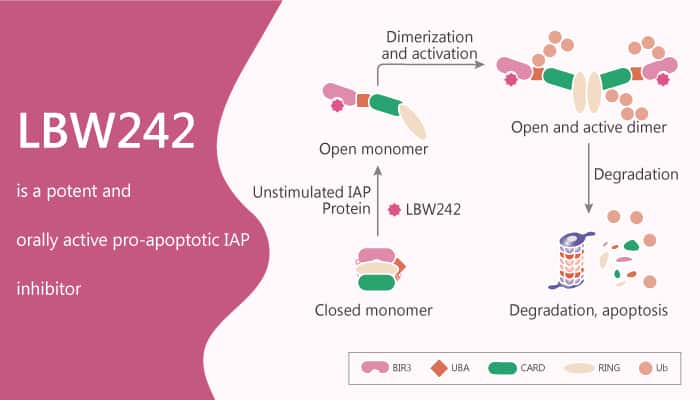Acute myelogenous leukemia (AML) is a hematologic malignancy. The characteristics include a block in cellular differentiation and aberrant growth of myeloid precursor cells. Approximately 30% of AML patients and a portion of acute lymphoblastic leukemia (ALL) patients express a mutated form of the class III receptor tyrosine kinase, FLT3. Mediators of apoptotic signaling represent an attractive target for therapeutic intervention. Smac mediates apoptosis occurring. It is through the intrinsic apoptotic pathway. It binds to and inhibits the inhibitor of apoptosis protein (IAP) family of proteins. IAPs also directly bind and inhibit active caspases. The BIR (baculovirus IAP repeat) domain is responsible for the anti-apoptotic activity of IAPs. In this study, LBW242 is an orally active proapoptotic IAP inhibitor. LBW242 is a 3-mer and Smac mimetic. Because it is based on the ability of the NH2-terminal seven amino acids of Smac to neutralize the BIR3 domain of XIAP.

LBW242 displays nanomoles-per-liter potency against XIAP and c-IAP-1 in a competitive binding assay with Smac 7-mer. Moreover, LBW242 also kills cells in a manner strictly dependent on caspases, and death is accompanied by PARP cleavage, Annexin positivity, and accumulation of cells in sub-G1. Furthermore, LBW242 partially inhibits the growth of mutant FLT3-expressing lines, such as MV4;11, at 1 μM. In addition, LBW242 inhibits a panel of PKC412-sensitive or PKC412-resistant, mutant FLT3-expressing Ba/F3 lines. The IC50 values range from 0.5 to >1 μM. In addition, LBW242 potentiates TRAIL- and anticancer drug-mediated cell death of ovarian cancer cells. Moreover, it reduces tumor burden in vivo.
In summary, LBW242, a 3-mer, and Smac mimetic is a potent and orally active proapoptotic IAP inhibitor. Meanwhile, LBW242 is effective against mutant FLT3 at doses that are physiologically achievable and well-tolerated in vivo.
Reference:
Weisberg E, et al. Mol Cancer Ther. 2007 Jul;6(7):1951-61.